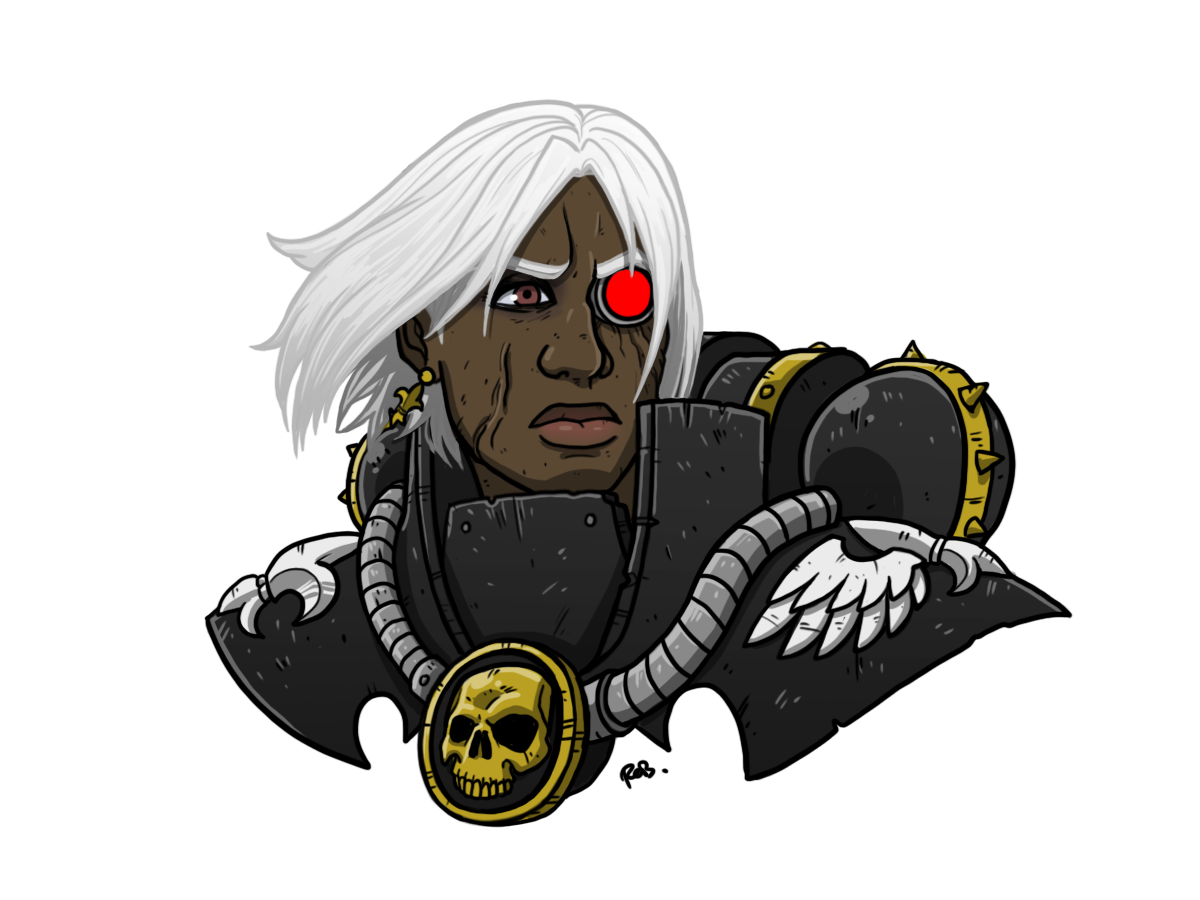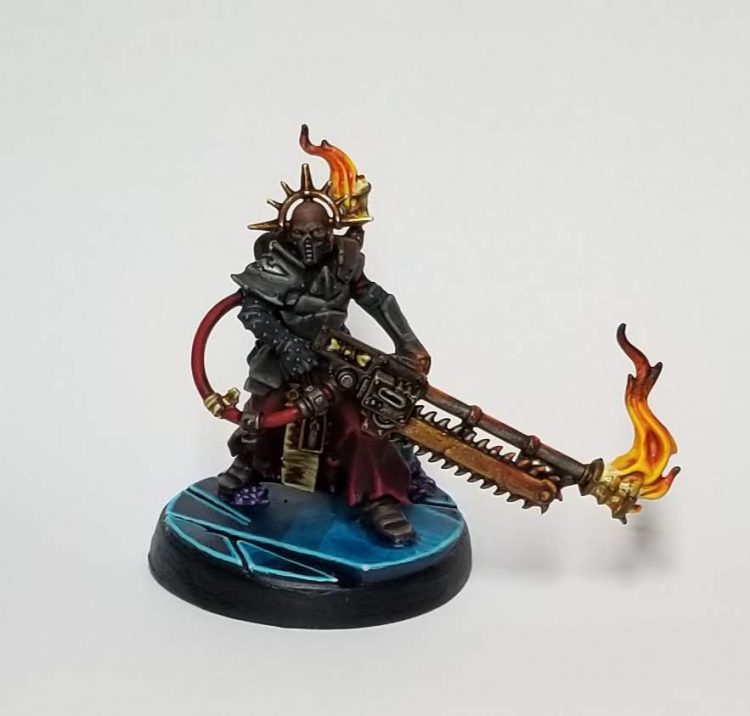The Adepta Sororitas, or Sisters of Battle, have had a rocky road through Warhammer 40,000. First released in 1997, right at the end of 2nd edition, they got a complete and all-metal range right before Games Workshop changed direction to place an ever-increasing focus on plastic. Their first codex lasting barely months before being replaced didn’t bode well for the Sisters; they were the very last army to get a 3rd edition codex, appearing in the Witch Hunters book in April 2004, once again just a few months before a new edition arrived, and after multiple other factions had a second codex of the edition. It didn’t get much better from there, with a long drought punctuated by White Dwarf and digital-only rules, and absolutely no changes to their model range even as other armies neared the 100% plastic mark.
After 22 years of hurt, though, the Sisters came back in a big way in 2019 with the Sisters of Battle Army Set, a limited-edition box containing a proper new 8th edition codex and a sampler of a new plastic miniatures range, followed up in January and February 2020 by a complete new plastics release covering every option in the book and adding several new units to the army. The book was pretty good, too, firmly pushing itself into the top tier in late 8th and early 9th edition.
Now here we are in June 2021, and with unprecedented alacrity, we have another Adepta Sororitas codex in front of us, as the Sisters are updated for 9th edition – and get another bunch of new units to boot. Games Workshop have once again been kind enough to provide us with a review copy of the book, and so without further ado we’ll dive right in and take a look at what’s changed.
Why Play Adepta Sororitas?
The Adepta Sororitas are a uniquely placed faction in Warhammer 40,000 – they remain regular humans, but are equipped with power armour and boltguns like the posthuman Space Marines. They exist outside of the control of the regular Imperial military, instead representing Ecclesiarchy as a faith in arms – and faith is the watchword here, because the Sisters really, truly believe, and in Warhammer belief is a very powerful thing.
On the table, the faction has an interesting dynamic, with great saves but low Toughness, a relatively circumscribed weapon range which is nevertheless uniquely suited to the demands of 9th edition 40k, and an array of mechanics that give the army a whole lot of oomph that goes beyond what the units’ fairly pedestrian statlines would suggest.
They’re also a painter and modeller’s dream; if you’re looking for a visually impressive army which personifies the gothic weirdness of 40k, this is the faction for you.
What’s in this Book?
- Lore for the holy warriors of the Adeptus Ministorum
- Army special rules for fielding an Adepta Sororitas list, with rules for 6 named Orders plus custom rules for an Minoris Order of your own, as well as the return of Sacred Rites and Acts of Faith
- Warlord traits, stratagems, relics, and a dedicated set of secondary objectives, as well as the new Blessings of the Faithful and Hymns of Battle
- A wealth of new units, including the Abbess Sanctorum herself, Morvenn Vahl
- Updated rules for the entire rest of the unit range
- Crusade rules which tell the story of your army, including the ability for your characters to become martyrs – or a Living Saint
The Five Best Things About This Book
- Morvenn Vahl: The Abbess Sanctorum is here in person, and she is good, possibly to the extent that she actually oppresses all other HQ options and is too good. But you won’t care as she scythes down heretics left and right.
- Better internal balance: Coming on the heels of the Vahl comment above this might appear contradictory, but it’s still true. The various Order Convictions feel a lot better balanced with each other, and there’s a greater diversity of builds which at least seem viable compared to what the 8th book had to offer.
- Blessings of the Faithful and Hymns of Battle: Two new categories of rules for the Sisters, adding an extra dimension to their gameplay and giving minor characters a bit more to do than just hang around hoping for their situational abilities to pay off.
- Big blocks of Sisters: Battle Sisters can now be taken in units of 20, offering a great vector for buffs and a fresh angle for horde-style play.
- Dominions are good again: They’re cheap, they pack a ton of guns, and most importantly they once again allow you to scout move their transport – and now they can bring other units inside of it with them, giving your melee options (like those shiny new Celestian Sacresants) some great forward momentum.
As ever, today’s review is going to focus on the matched play rules from this book. Check back in next week for lots more content, including a Crusade review, Hammer of Math deep dives and more.
The Rules

Detachment Rules
This section lays out all the rules for creating an Adepta Sororitas detachment, which unlocks the various rules in this section.
There’s two key administrative rules in the Detachment Abilities section, the Decree Passive and Order Convictions. These simply set out some basics for army construction; the Decree Passive restricts you to one CANONESS and one MISSIONARY per Detachment, and stops you having more CULT IMPERIALIS PRIEST than ADEPTA SORORITAS CHARACTERS in a single detachment. Order Convictions are what you would expect; all ADEPTA SORORITAS units with the ability gain a conviction as long as you only have units from one <ORDER> in a detachment. We’ll talk about these more below. There’s also a few more bits of Keyword admin – the OUTCAST and SANCTIFIED keywords are two flavours of the standard “can go in any detachment without breaking it”, while CULT IMPERIALIS is the keyword for all the MInistorum stuff in the book, and can be included in a detachment without stopping it being an ADEPTA SORORITAS detachment (as can Agents of the Imperium).
Note that that last one has a subtle impact – unless and until they get errata, bringing ADEPTUS MINISTORUM units from other sources that don’t have the CULT IMPERIALIS keyword breaks your detachment rules (and also breaks Acts of Faith, now a pure army bonus). Put that Ministorum Priest datasheet from the Guard book down. That’s right, we see what you’re doing there.
Army-wide Rules
Shield of Faith
Shield of Faith is similar to the old version – a 6+ invulnerable save and a free 1D6 Deny the Witch for each unit – but with one key difference, which is that a roll of a 6 automatically denies the power. This makes it much more powerful, since there’s longer the possibility of a casting roll you simply can’t beat; 16% of the time you will just poof that power away no matter what. This is even more powerful when combined with the new Aegis of the Emperor sacred rite, which changes this to an unmodified 5+.
Zealot
As before, this allows you to re-roll hit rolls for melee attacks in a turn where your unit charged, was charged, or made a Heroic Intervention.
Acts of Faith
Acts of Faith are now your bonus for being monofaction – you can only gain Miracle dice if every model in your army has the ADEPTA SORORITAS, CULT IMPERIALIS or AGENT OF THE IMPERIUM keyword. No more miraculous soup.
Acts of Faith are the same as before, allowing you to gain Miracle dice and then use them once per phase to perform an Act of Faith to substitute for dice in a list of key rolls. The biggest changes are the mechanics for gaining dice – you’re now restricted to just Vengeance (destroy an enemy unit) and Sacrifice (one of your ADEPTA SORORITAS CHARACTER units is destroyed). Purity and Valour have both gone; the removal of Purity also knocks on to the list of Acts, with you no longer being able to use an Act of Faith to substitute for a Deny the Witch test, presumably to remove the possibility of an auto-dispel.
Sacred Rites
Sacred Rites make a return from the previous codex, with evolutionary rather than revolutionary changes in place – mostly bringing them up to 9th edition standards. Hand of the Emperor, Divine Guidance, and The Passion are basically identical, while the other three have had more substantial changes – Spirit of the Martyr now causes mortal wounds to an attacker assuming they kill you in melee and you then roll a 6 (yawn), Aegis of the Emperor boosts your Shield of Faith ability to auto-deny on a 5+ (as mentioned above), and Light of the Emperor allows you to ignore all modifiers to Leadership and Combat Attrition tests. There’s a bit more going on with Rites in this book, with support for switching them mid-game or gaining bonus ones via the Hymns of Battle (below), which hopefully will make them more meaningful.
Subfactions
There’s six Orders Majoris here, as are well-established in the fluff, each with a trait, a relic, a stratagem, and a Warlord trait. Additionally there are a number of custom traits for the Orders Minoris, in the standard “mix and match 2” format with a few restrictions.
Order of Our Martyred Lady
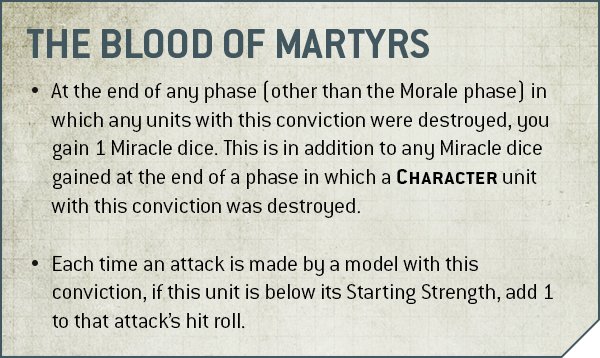
The “classic” Sisters Order opens up with a trait nearly identical to the 8th edition one, only updated for 9th edition wording – extra Miracle dice for destroyed units, and +1 to hit for units below Starting Strength. There’s only one significant change here, which is that the +1 to hit no longer persists if you later get the model back.
Stratagem – Honour the Martyrs – 1CP
When a Martyred Lady character is destroyed by an enemy unit, you can spend 1CP on Honour the Martyrs and now all of your Martyred Lady units get +1 to wound against that enemy unit. A reasonably substantial buff from the prior book, where this was re-roll 1s to hit – +1 to wound is a much less common effect in this army.
Warlord Trait – Shield Bearer
A reasonably strong trait, Shield Bearer reduces Damage taken by the Warlord by 1 (uncontroversially it specifies a minimum of 1 – more on this in Units later), and also makes the Miracle dice an automatic 6 if you either gain one for Vengeance when the warlord kills something, for Sacrifice in general or a the end of any phase in which the Warlord was destroyed.
Relic – Martyr’s Vengeance
A 12”, S9 inferno pistol that always does D6+3 damage. As weapon relics go, this is surprisingly spicy – you might actually do real damage to something that matters.
Order of the Valorous Heart
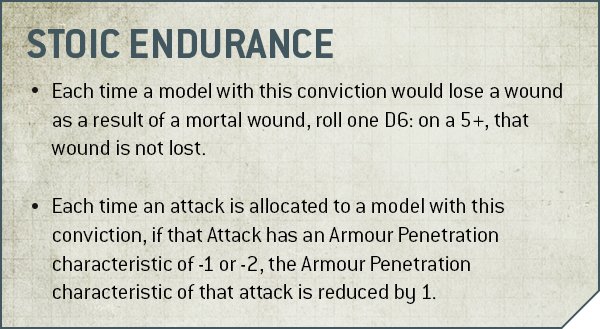
Trait – Stoic Endurance
Valorous Heart units get a 5+ to ignore mortal wounds, and can reduce AP by 1 against AP-1 or AP-2 attacks – a nerf to their overall endurance from the previous ignore AP-1 (or AP-2, with an Imagifier) and 6+ to ignore any wounds. It’s still a fine trait to build a durable Sisters army, but less good than before.
Stratagem – Blind Faith – 1CP
For 1CP, you can ignore any or all negative hit modifiers in either the Shooting or Fight phases. Probably the most significant place this is going to come into effect now is for Retributors, which no longer ignore the move and shoot penalty with Heavy weapons naturally, but may also come into play for Repentia. In general this has been way less relevant in 9th, so it’s nice to see it given broader use cases.
Warlord Trait – Impervious to Pain
Each time the Warlord performs an Act of Faith they restore 1 lost wound, and they also gain a 5+ to ignore wounds. A perfectly fine trait which mostly is held back by Canonesses (the most likely place to use it) just not being that tough in the first place.
Relic – Casket of Penance
A 3” aura of -1 Toughness for enemy units, with an added -1 Strength for CHAOS units. Merely ok – too often you’re just not going to really change any maths with this, but it’s nice that it now reaches out to 3″ so that you can leverage it during shooting. Most likely this starts showing up if Knights ever start rampaging across the metagame again, as for an army packed with melta weaponry reducing T8 by by one is a big deal. The other thing might be to use this against the upcoming T5 Ork Boyz, but bear in mind that if you try and do that confusing things around slow rolling start happening, as the enemy can prioritise pulling models from the (small) radius.
Order of the Bloody Rose
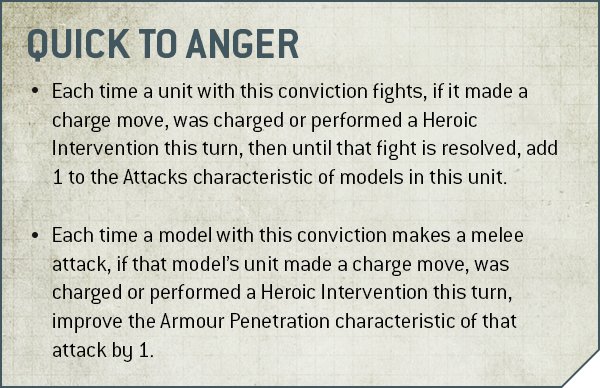
Trait – Quick to Anger
Bloody Rose retain the +1 Attack for units in the first round of combat, as well as improving the AP of melee weapons by 1, but lose the bonus AP to pistols – a relevant consideration for e.g. hand flamer-toting Seraphim. They’re still the punchiest order, but lose the incidental and yet incredible boost to Seraphim they used to have alongside it.
Stratagem – Tear Them Down – 1CP
Use in the Fight phase; melee attacks score an automatic wound on an unmodified 6 to hit. A reasonably good stratagem for any unit with a high volume of attacks, but a massive step down from the raw power of its previous +1 to wound incarnation.
Warlord Trait – Blazing Ire
+1 Attack and Advance and charge – a great trait to give a melee Canoness a little more juice, such as one wielding the Blade of Saint Ellynor or Beneficence. It may well be likely to see play as a bought trait for a punchy Canoness, because Righteous Rage (generally the better melee boost) is locked in on Morvenn Vahl, who will be your warlord a lot of the time.
Relic – Beneficence
The relic chainsword makes its return, with an altered profile – it’s now S+2 but only D1, and it retains the bonus 3 attacks but gains an additional ability to grant D3+3 attacks if there are 6 or more enemy models within 3”. The lower damage sucks, but you’re marginally more likely to land a wound in the first place and can potentially pick up greater numbers of attacks against hordes, which isn’t nothing.
Order of the Ebon Chalice
Trait – Daughters of the Emperor
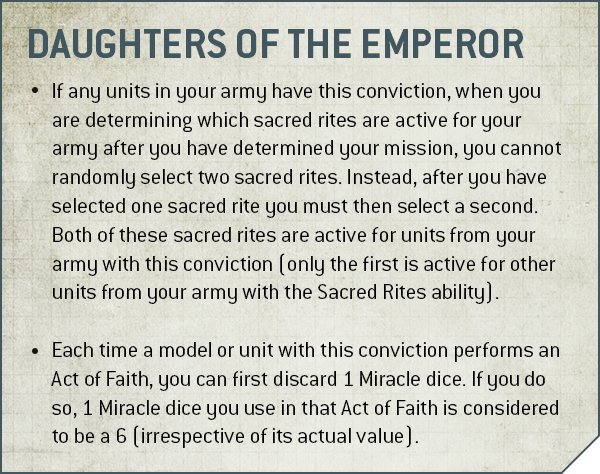
The Ebon Chalice get not one but two active Sacred Rites, which is a reasonably big win when you consider that there are two fantastic melee options in the shape of Hand of the Emperor and The Passion and you can now take both. Additionally, when you use an Act of Faith, you can first discard a Miracle dice; the dice you then use for the Act is automatically counted as a 6. You are likely to have fewer Miracle dice than before, but this is definitely helpful for making sure that you’ve got a 6 on hand whenever you need one.
Stratagem – Cleansing Flames – 1CP
A potentially excellent stratagem, adding +4” range to flame weapons in a unit and allowing them to cause a mortal wound on a 4+ to wound (up to a maximum of 3). 1CP for 3 mortal wounds is a reasonably good trade, and it’s trivial to put this on a unit of Seraphim with hand flamers where it’s almost guaranteed to go off.
Warlord Trait – Terrible Knowledge
If your Warlord is on the battlefield, your first Miracle dice at the start of the first battle round is automatically a 6; additionally you can roll a D6 for each Command point spent using a Stratagem and on a 5+ it is refunded. A great bread and butter trait which lets you kick off the game with a good Miracle dice in hand, and keep up generating a steady stream of Command Points.
Relic – Annunciation of the Creed
Replaces a condemnor boltgun with one where the stake mode that has a bonus point of AP and does a flat 3 mortal wounds to psykers instead of the normal d3. Potentially hilarious for blasting psykers off the table, but probably not a worthwhile use of your relic slot in an all-comers list.
Order of the Argent Shroud

Trait – Deeds, Not Words
Each time a unit with this conviction makes a Normal Move or Advance Move it counts as having Remained Stationary until the end of your Shooting phase. Additionally, each time you shoot or fight, you can re-roll one hit roll or one wound roll.
A really strong trait – possibly the most powerful of the six on offer – which gives you a lot of flexibility for a mobile shooting army. The re-roll is a really helpful thing to have on hand (and shows up again in the minor Orders, where it’s one of the best picks) and being able to move (or indeed advance) and shoot without penalty is a great buff. Re-rolls like this are best on armies that can scatter a few powerful weapons in a lot of squads, and that absolutely describes the melta-happy Sisters.
Stratagem – Faith is Our Shield – 1CP
Use in any phase, when an Argent Shroud model would lose a wound as a result of a mortal wound; you can ignore this wound and any other mortal wounds in that phase on a 4+. A decent back-pocket stratagem if your other anti-psychic defences fail, or possibly also against something like a vehicle explosion or one of the increasing number of weapons with a mortal wound component since it’s any phase.
Warlord Trait – Selfless Heroism
6” heroic intervention and fight first; fine for what it is, but this isn’t really the Order for building a murder character.
Relic – Quicksilver Veil
+3” to Movement and -1 to hit rolls against the bearer. Mostly fine, could plausibly see some use as a delivery mechanism for one of the Blessings of the Faithful.
Order of the Sacred Rose

Trait – Devout Serenity
Automatically pass Combat Attrition tests, and every time a unit performs an Act of Faith, gain a Miracle dice on a 4+. A decent trait especially for big blocks, where losing no more than 1 to Morale ever can be potentially helpful, and for keeping Miracle dice flowing.
Stratagem – The Emperor’s Judgment – 1CP
Use in the Shooting phase; attacks with ranged weapons do an extra hit on an unmodified 6 to hit. A decent stratagem, especially if you have units with high shot volume – massed bolters under Defenders of the Faith (see below) seem like a good pick here.
Warlord Trait – Light of the Divine
Once per turn, when the Warlord performs an Act of Faith, one Miracle dice used automatically counts as a 6 regardless of its actual value. Additionally, CORE units within 6” can shoot even if they fall back. A decent trait, allowing your Warlord to make the most of any Acts of Faith they utilise themselves, and giving your units room to disengage and shoot – helpful for untangling from melee if necessary.
Relic – Light of Saint Agnaetha
Replaces a brazier of holy fire with a version which removes the “one use only” clause. Yawn.
Minoris Convictions
There are 16 different Minoris Convictions available, of which you can mix and match 15 (subject to a few restrictions specified in the text themselves, e.g. you can’t mix Devout Fanaticism with Holy Wrath). The 16th is In the Footsteps of Saints, which takes up both your picks and allows you to effectively play a successor to a particular Order Majoris. There is literally no reason to ever do this unless you are dead set on the fluff of it, but if you are then go off, we guess.
Some of these mirror traits from the major orders, either directly or indirectly – Guided by the Emperor’s Will is just a copy of the re-roll component of Argent Shroud, while Shield of Aversion treats AP-1 as AP0, a weaker version of the Valorous Heart trait. Possibly the most likely combo coming out of the book is Guided with Raging Fervour, which treats all Pistol and Assault melta weapons as always being in half range, and Heavy ones as being in half range at 18”. If you really just want to maximise the impact of your meltaguns, this combo seems like a clear winner. Alternatively, go for Rites of Fire (which is exclusionary with Raging Fervour and also with Unshakable Fervour, which affects bolt weapons) and gain 4” range to all your flame weapons.
Stratagems
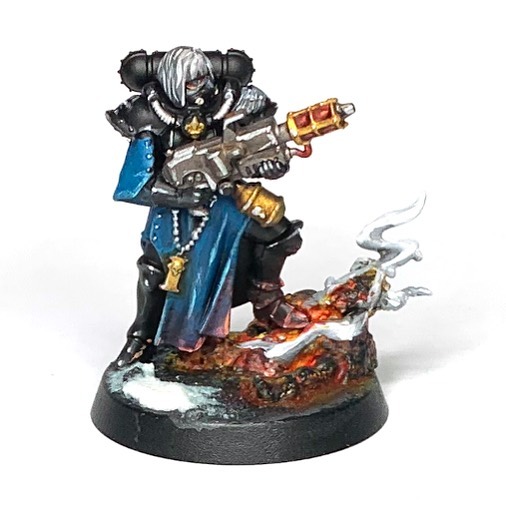
Sisters had one of the best Stratagem sections in 8th edition, with a great mix of possibilities which enhanced units across the army. Naturally this couldn’t be allowed to stand unchallenged, and there have been a surprising number of changes made.
First and probably most importantly if you are a current Sisters player – Embodied Prophecy, Holy Rage, and Deadly Descent have all taken substantial changes, and Storm of Retribution is completely gone. Storm is a one-two punch for Retributors, as we’ll see in the datasheets section, substantially depowering one of the last book’s premier units.
Looking at the others mentioned, Embodied Prophecy now is +1 to wound for the Zephyrim (rather than a re-roll 1s to wound aura for the things around them), Holy Rage now allows re-roll hit rolls or fall back and charge, and Deadly Descent still allows you to shoot but doesn’t boost range, meaning you can no longer shoot inferno pistols out of deep strike – a severe nerf for those. It also now happens at the end of the phase, so it’s no longer possible to use it to clear a space for other deep strikers.
There’s a few other returnees with substantial changes. Exceptional Proficiency is also +1 to hit now rather than re-rolls to hit, while Martyred generates Miracle dice instead of Command Points. Devastating Refrain now makes your Exorcist able to shoot without line of sight, instead of re-rolling the shots number. Final Redemption now applies to ENGINES OF REDEMPTION instead of Repentia, and does d3 mortal wounds instead of 1, and Divine Intervention is once per game. Suffer Not the Witch is now +1 to hit, or +1 to wound as well if used by a CHARACTER model. Desperate for Redemption is no longer a fight twice, but instead allows Repentia to fight after they die in the manner of Wulfen, while Blessed Bolts no longer buffs weapon damage (which matters less as storm bolters are now ‘artificer-crafted storm bolters’ and damage 2 base), and instead allows you to do 2 mortal wounds for every unmodified 6 to hit with a storm bolter, to a maximum of 6.
In terms of what’s here and mostly unchanged, we have Cleansed by Fire (does the same, but no longer Ebon Chalice exclusive), Extremis Trigger Word, Martyr’s Immolation, Moment of Grace (though now 1-2 dice rather than 1-3), Battle Rites, Purity of Faith, Faith and Fury (now only 1CP), Holy Trinity (with new, easier to activate wording), and finally Judgement of the Faithful (now only 1CP, but also now only fall back and shoot – fall back and charge now sits with Holy Rage).
That leaves just a few genuinely new stratagems. Holy Smokescreen is the same -1 to hit stratagem that has appeared in other places such as Space Marines, while Rites of Restoration allows a Hospitaller to spend 1CP to resurrect D3 CORE INFANTRY within 3”. Suffering and Sacrifice is also 1CP, and similarly to the Blood Angels’ Angel’s Sacrifice stratagem allows you to force an opponent to target a character so long as they are either your Warlord, a LIVING SAINT, or a SAINT POTENTIA (Crusade-only). Angelic Ascent also borrows from the Blood Angels, imitating Upon Wings of Fire, while for 2CP Defenders of the Faith is a kind of pseudo-Transhuman Physiology – you can only use it on a BATTLE SISTERS SQUAD and you declare it at the end of your Movement phase on a unit within range of an objective, so it lacks the reactive component, but you can also give the unit the ability to Rapid Fire at full range (i.e. Bolter Discipline) as well as not being wounded on a 3 or worse. With basic Battle Sister squads going up to a maximum of 20 models in this book (yes, really, check out the Units section below), this is a potentially powerful option for shoving a brick of Sisters onto an objective and giving your opponent a significant headache when trying to remove them.
Righteous Impact replicates Hammer of Wrath, with Paragon Warsuits or ENGINE OF REDEMPTION units being able to roll 1d6 for each model in their unit when they reach Engagement Range and do a mortal wound for each roll that exceeds the target unit’s Toughness, while Thrice-Blessed Hull works on any HALLOWED unit (i.e. the tanks, including the humble Rhino) and makes it so that any psyker within 12” automatically takes Perils for any failed Psychic test.
Last but not least we have Inviolate Shieldwall, usable by Celestian Sacresants or Crusaders, giving them -1 to wound against melee attacks for 1CP. This is really good on the Sacresants in particular, and is likely to help push them into a lot of lists.
Overall this is a surprisingly sweeping set of changes to a stratagem section that didn’t exactly feel like it was underperforming. If you’re set in the ways of 8th edition Sisters some of these will feel like real gut-punches, but it’s worth reading further into some formerly-neglected datasheets – for example, the Holy Rage changes aren’t as bad as they look, as the Repentia Superior can now grant both advance and charge and also 3d6 drop lowest for the charge roll with a Command phase ability. Of the absolutely new stratagems, Defenders of the Faith seems like a clear high point – one of the weaknesses of Sisters is their low Toughness, and being able to negate that is helpful for keeping them on the table.
Warlord Traits
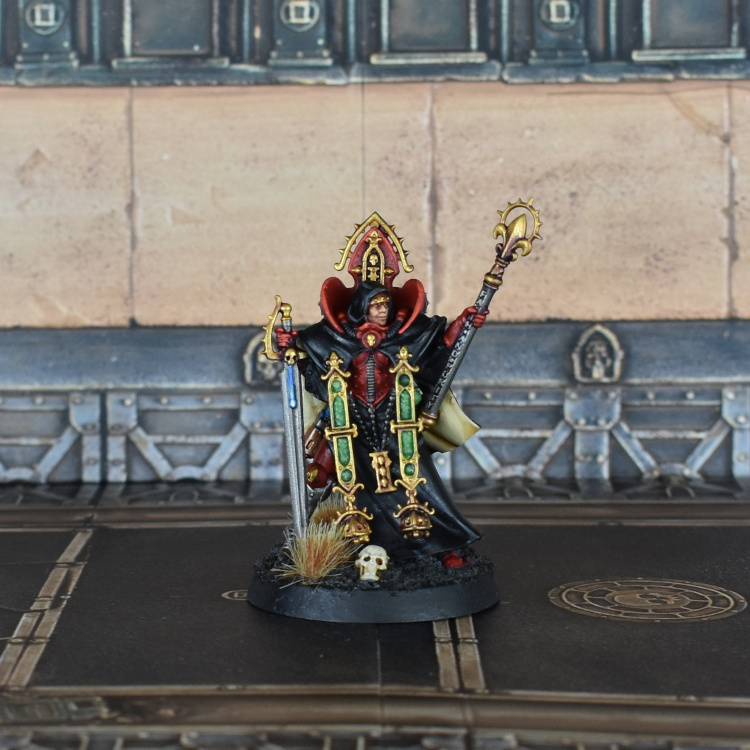
As standard, there’s six Warlord traits on offer here, and while the names are all the same there’s a reasonable number of changes on offer.
The immediate standout from this list is Righteous Rage, which now mirrors Hatred Eternal from the Drukhari codex, allowing the Warlord to re-roll all hits and wounds in melee. This is a strong trait by itself, but it’s also Morvenn Vahl’s required trait, and she is already a beast in combat – why would you not make her your Warlord?
Indomitable Belief also returns mostly unchanged (adding a CORE rider) and is more important than ever, as all the other Aura sources of boosting Shield of Faith are gone from the book. While only being able to go to a 5++ for most things is weaker, you’re definitely still going to want this in many armies.
Inspiring Orator has also gotten some boosts, which gives +3” to hymns or Command abilities, and also grants an aura that allows CORE units within 6” to ignore the Combat Attrition penalty for being below Half Strength.
Besides those this is a fairly thin section of the rules though – Beacon of Faith takes a massive nerf, generating one Miracle dice which can only be used by your Warlord and which also disappears if not used, while Executioner of Heretics is still worthless. Pure of Will swaps the -1 to cast effect for a +3 to Deny rolls, which is nice and possibly worthwhile if you’re really expecting a psyker-heavy meta (though note that the auto-Deny on a 6 is for unmodified rolls).
Relics
A fair number of the relics from the last codex return unchanged, or with only minor tweaks – most confusingly, the Blade of Admonition is now a Crusade relic, but there’s an identical weapon in the regular relics section called the Blade of Saint Ellynor. There’s a mix here of buffs and nerfs; Wrath of the Emperor goes down to AP-1 and Litanies of Faith becomes once per battle round instead of once per turn, but the Iron Surplice now gives +1 wound on top of its previous effect.
Possibly most exciting from the returnees are the Mantle of Ophelia – still CANONESS only, but which now makes any attack allocated to the bearer Damage 1, achieving the rare distinction of being a genuinely worthwhile defensive relic – and the Triptych of the Macharian Crusade, which completely loses its old effect and instead grants +1T, a 4+ invulnerable save, and the ability to make the first failed saving throw per turn count as being Damage 0.
One bonus in this book is that the new layout, with Order relics and such printed on the Order pages instead of in the regular Relics section, means that there’s room for a few new toys. Enter the Ecclesiarch’s Fury, a relic chainsword with S+2 AP-3 D2; it’s -1 to hit but +1 to wound, which overall works out pretty well when you think about it, especially if you can get a source of re-rolls or a way to ignore the hit modifier such as the Blind Faith stratagem. There’s also Redemption, a variant of the always-overcharged plasma relic gun which is becoming common, and which works like Mortarion’s pistol where it draws a line between the firer and the target and rolls to wound against every unit it passes over.
The Blessings of Sebastian Thor grant 2 sacred rites to the bearer’s unit instead of 1, while the Simulacrum Sanctorum imitates the Venerated Saint stratagem from the previous codex. That leaves us with the Chaplet of Sacrifice – allowing a free Epic Deed, re-rolls to hit for the bearer, and the ability to shoot or fight on death – and the PRIEST-only Sigil Ecclesiasticus, or “pay 1CP to make your Hymn-bot twice as good” as it lets the bearer know +1 and intone +1.
Overall there’s a pretty reasonable set of toys available here, and it’s nice to see some more creative ideas about how to make defensive relics that aren’t just “bearer is -1 to hit.” The Sigil probably stands out as the best single item, just to give you more flexibility with Hymns, but there’s interesting possibilities with Ecclesiarch’s Fury too. It’s also worth noting that A Sacred Burden allows you to spend 1CP to give a Superior model any of the Blessings of Sebastian Thor, The Ecclesiarch’s Fury, Litanies of Faith, or Redemption, which opens up some possibilities, particularly if you’re otherwise running named character-heavy – as is very possibly the case.
Blessings of the Faithful
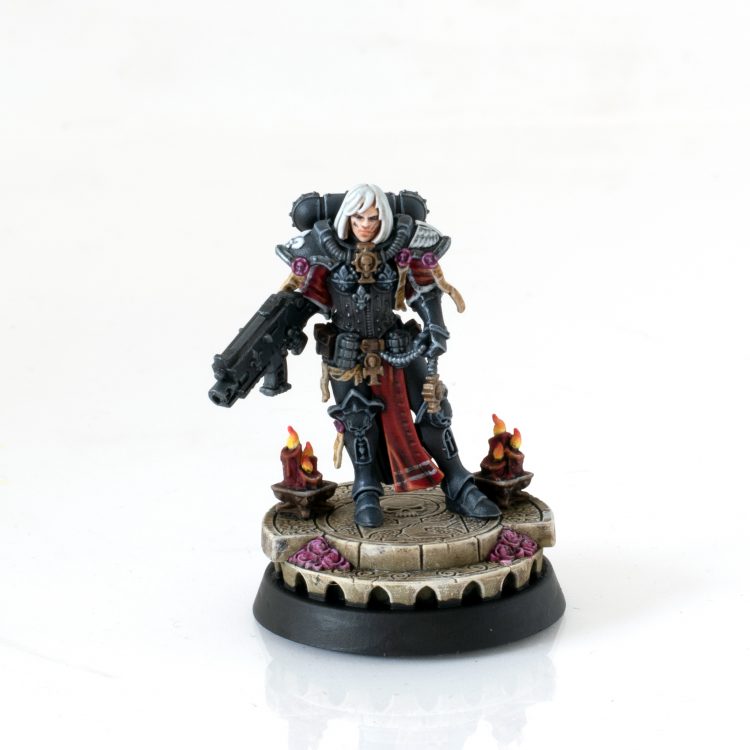
Similarly to other 9th edition factions, Sisters have gained a set of character upgrades which you can purchase with points; in this case, you can take one Blessing of the Faithful for each CANONESS or PALATINE unit in your army (excluding named characters). There’s 6 of these on offer, with the cheapest being Divine Deliverance at 15pts, while Word of the Emperor is the most expensive at 40pts.
Each blessing has two parts; the first is an always-on ability, while the second is a “Miraculous ability” which can be used once per game – they’re activated in your Command phase and then last until your next Command phase. You use these by spending a Miracle dice, with the value determining what range your ability has – discard a 1 and the ability has a 1” range, a 2-5 and it has a 3” range, while a 6 will give you a mighty 6” to work with. Notably, these are explicitly not auras, so they are not affected by abilities which increase aura ranges – but also can’t be disabled by anti-aura abilities.
Warhammer Community already previewed Word of the Emperor, which works as below:
The fight last effect is a little less powerful following the recent FAQs, but the Miraculous ability is pretty powerful – it’s only once per game, but if you can get it off at a key moment against the right target it’s a valuable effect.
The Emperor’s Grace is also a great buy for 20pts – your model heals d3 wounds at the start of each of your Command phases, and then once per game, for any CORE or CHARACTER unit that is within Miracle range, an opponent cannot re-roll hits, wounds, or Damage rolls. This is a powerful ability to have available, especially since Paragon Warsuits are CORE – a Canoness babysitting a set of these and turning off re-rolls on turn 1 or 2 can potentially keep them alive and firing a turn longer.
There’s also some turnabout available; as we mentioned, these aren’t auras and so can’t be affected by anti-aura abilities, but Divine Deliverance can do over other people’s; in your opponent’s Command phase you pick an enemy unit within 6” with at least one Aura ability, pick one of those abilities, and if you can beat their Leadership on 3D6 that aura turns off until the start of their next Command phase. Potentially spicy stuff, though possibly a little hard to set up – though you get your own turn’s worth of movement and fighting to get in place for it. The paired Miraculous ability makes it so that a CORE or CHARACTER unit in range can an enemy unit’s Leadership by 1 for each model they destroy with a ranged attack, to a maximum of -3.
Hymns of Battle
In the ongoing quest for Sisters to adopt everything Space Marines have, they’ve gained their own Chaplain-style prayers, in this case called Hymns of Battle. These are actually spread around a little more broadly than the Space Marine or Chaos Space Marine equivalents, since there’s more types of PRIEST in this army – the regular 25pt Preacher just knows the default Prayer, War Hymn, which is similar to their old aura ability but now just affects one CORE or CHARACTER or ENGINE OF REDEMPTION unit within 6”, granting them +1 Attack until the start of your next Command phase. Missionaries know War Hymn and can pick one of the first three abilities, while the Dogmata can pick from any of the six. An interesting note here is that the Dialogus also knows Hymns, giving her an additional role that she didn’t have before – and in fact, as we’ll discuss in the Units section, the Dialogus has had a significant upgrade in general.
As mentioned, there’s six of these in total on top of War Hymn – in order they are Refrain of Blazing Piety (basically a Smite), Chorus of Spiritual Fortitude (removes the effects of any psychic powers on a unit, and stops other psychic powers affecting them), Psalm of Righteous Smiting (buffs the PRIEST themselves with +1 Strength and Attacks, additional point of AP, though not on Relics, and the ability to fight again at the end of the Fight phase), Litany of Enduring Faith (+1 invulnerable save for Shield of Faith), Verse of Holy Piety (get an additional Sacred Rite for the turn), and Catechism of Repugnance (attacks with bolt weapons auto-wound on a 6 to hit and get an extra point of AP at half range).
Of these the most interesting ones are Chorus of Spiritual Fortitude, a great counter-pick against psychic-heavy armies, and Litany of Enduring Faith, especially since it’s much harder to otherwise improve your Shield of Faith save now. A Dogmata may also find some interest in Psalm of Righteous Smiting, buffing her to S6 AP-3 D2 with 4 attacks, 5 if she also casts War Hymn on herself.
The only thing to watch out for here is that each Hymn can only be used once per turn, meaning you can’t hand out War Hymn to all and sundry. You need to make sure you’re putting it where it counts, and make sure you always have enough useful things for your Priests to do.
Secondary Objectives
Sisters pick up 4 new secondary objectives, across a diverse range of categories – one each for No Mercy, No Respite, Shadow Operations, Purge the Enemy and Battlefield Supremacy. These work as follows:
- A Leap of Faith – No Mercy, No Respite: At the end of each turn, you gain 1 point if you performed 2 or more Acts of Faith, or 2 points if it was your opponent’s turn. You gain an additional point for performing 3 or more. Acts with Cherubs don’t count, and you can score a maximum of 12 points.
- Sacred Grounds – Shadow Operations: One ADEPTA SORORITAS INFANTRY or CULT IMPERIALIS PRIEST unit can perform the Sacred Grounds action each turn, starting at the end of your Movement phase and finishing at the end of your next Command phase (or the end of the battle), assuming they’re in range of an objective marker you haven’t already consecrated, and there are no enemy units in range. If completed, you score 1pt at the end of the game for an objective wholly within your deployment zone, or 4pts for one outside of your deployment zone. The marker also gains the Inspiring (ADEPTUS MINISTORUM) terrain trait.
- Slay the Heretic – Purge the Enemy: You gain a point at the end of your Shooting phase for destroying an enemy unit with each of a bolt weapon or a flame weapon or a melta weapon (i.e. if you destroy one enemy unit with a boltgun and another with a Ministorum flamer, you would score 2 points). If you manage all three, you get an additional point for a possible max of 4 per turn.
- Defend the Shrine – Battlefield Supremacy: If you pick this then after both sides finish deploying, your opponent can pick one objective on the battlefield which is not in their deployment zone; this is the Sacred Shrine. You gain 3pts at the end of your turn if you control this marker, and an additional 3pts if you control it at the end of the battle. However, if your opponent holds it at the end of the battle, you lose 3 of the points you scored on this objective (to a minimum of zero – so if you didn’t score anything, you can’t go negative).
This is an interesting selection of secondaries. A Leap of Faith is probably whatever; it’s not that complex to score but capping at 12 gives it fairly low upside, and it incentivises you to play weirdly just to score it. Sacred Grounds is potentially strong, with a number of the maps in the GT pack opening up some high scoring potential thanks to their layouts (particularly worth a look on the Scouring and Vital Intelligence, with 5 objectives outside your deployment zone, though also it’s worth noting that in Scorched Earth there are 6 objectives and none are “wholly” in your deployment zone, instead straddling the line). Being able to do it with various flavours of CHARACTER also heavily mitigates the fact that the Action lasts until your next turn – a cheap Priest can potentially pick up one or two objectives on their own, reducing the headache of committing a unit to a long action.
Slay the Heretic may be a little difficult to pull off if you’re required to line up killing exactly the right units with the right kind of weapons, while Defend the Shrine has a reasonable scoring window of 18 available points, but allows your opponent to dictate your plan, and gives them a very unusual ability to claw points back off you. On some maps there’s still value there, as if you’ve built a steamroller of a list that wants to surge towards one objective then hold it tight, this lets you focus on that to the exclusion of most other things and still pick up a 15 as long as you’re in position by the end of your second turn. It’s notably a complete nightmare on Battle Lines, where your opponent has the choice of two equidistant mid-table objectives, which is really no choice at all – so long as you’ve not put yourself well out of position for one of them.
The Units
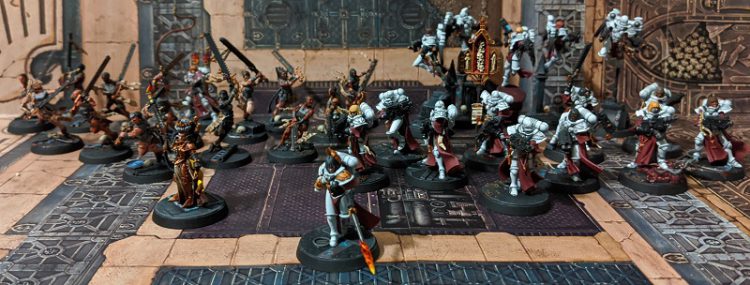
Equipment
As a general note before we jump into units, there are a few consistent equipment changes across this book. It looks like there was a goal that all weapon upgrades should be worth at least 5pts so costs could be nice rounded numbers – and to make some choices worthwhile at that price, they get an upgrade over regular flavours.
Most notably, this impacts on storm bolters and all flamers. Every flame weapon in this book is a “Ministorum” flamer, which in practice means +1S – so S4 for hand flamers, S5 for regular, and S6 for heavy. All good stuff, especially on the latter two given the ominous T5 green tide on the horizon. Meanwhile, the storm bolters you buy as unit upgrades (not the ones attached to vehicles or paragon suits) are now “artificer-crafted storm bolters”, which have D2, which is definitely one way to make them worth 5pts! The other change is that the condemnor boltgun is now a combi-weapon, with a normal boltgun mode and a stake launcher (plus the ability to fire both at -1 to hit). The stake mode is pretty nifty – it’s S4 AP-1 D2, and if the wound is allocated to a psyker (so after rolling to wound but before making saves) they take an additional d3 mortals. They’re not cheap at 10pts, but it’s nice to see them get broad utility outside their one specific use case, and being really good at that.
Outside of these, it’s business as usual for Imperium weaponry, and the Sororitas unit upgrades have returned pretty much unchanged – Incensor Cherubs still give you a once-per-game unit specific Act of Faith, and the Simulacrum still lets a unit perform an extra Act (though you do now have to pay 5pts for Simulacra again).
HQ
Morvenn Vahl
We start with the new Sister on the block, High Lord of Terra and Supreme Commander of the Adepta Sororitas Morvenn Vahl herself – and readers, she is off the charts good.
This is one of the best new datasheets that GW have put out in ages, to an extent that is going to warp army construction and this book around it. As a Sanctified HQ with the Supreme Commander keyword, there are multiple angles to trivially slot her into any Sororitas list, and vanishingly few reasons why you ever wouldn’t even at her 265pts price tag.
Morvenn combines being a killing machine in her own right with force multiplication capabilities matched only by Guilliman. Warhammer Community took a look at her (very nasty) spear and statline, giving her either five big swings at D3 or ten hit rolls with a sweep attack but what they left out is that her mandatory Warlord trait (and she has to be your Warlord) is Righteous Rage, so she’s on full re-rolls all the time, and in the rare situation that she isn’t able to punk something straight away, once per game she can just straight up Fight Again at the end of the phase – which she will almost certainly survive to given she halves incoming damage and has a 2+/4++. She’s also surprisingly dangerous at longer ranges, packing an amped up S6 heavy bolter and having what is essentially a twin missile launcher strapped to her shoulders. She’s thus very far from idle even when she hasn’t hit melee yet, and is extremely good once she does.
Layered on top of that premium statline are two buff effects. She has an Aura that combines the effects of a Canoness and Palatine, so re-roll 1s for both hits and wounds for CORE, and as you’ve probably come to expect from a character of this tier, gets to pick one nearby CORE or CHARACTER unit to supercharge in your Command Phase. This isn’t just the standard full hit re-rolls though – the chosen unit gets to re-roll all hits and wounds until your next Command Phase.
That is, obviously, completely wild, and access to this effect changes the maths on an enormous range of units. It makes any specialist unit exceptional at its job, and turns 20-model Sister blobs (we’ll get to that) into fantastic all-purpose killers, lets you use some of the other named characters as deadly precision tools and in the very worst case, if she’s miles from anything, slapping full re-rolls on her missile launcher shots is fine.
If you play this faction, get this model – pretty much every competitive list we’ve come up with uses her, to the extent that she kind of leaves Canonesses or Palatines looking a bit purposeless unless you want access to Blessings of the Faithful (which to be fair you sometimes will). We’re honestly not massive fans of the design here – she’s just good at everything, can be put into any list and is competitively priced – so why wouldn’t you bring her?
Named Characters
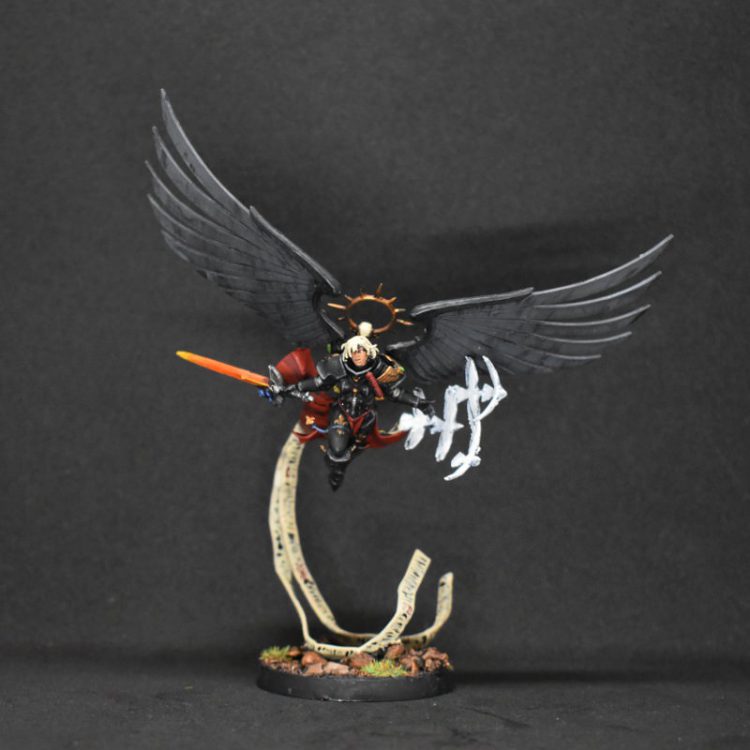
The Sororitas had a healthy roster of Named Characters already, and there are quite a few shakeups among them.
Big winner, and new inductee into the actual book, is Ephrael Stern (plus some Harlequin guy). This dynamic duo can be taken either in a Sororitas detachment (where their Outcasts keyword lets them not break anything) or an Auxiliary Support and they got a lot better. They now function as a unit of two models on the battlefield, with a special rule that means Kyganil always has to take wounds first, and essentially that unit has all the special abilities each had separately before combined plus a key boost for each of offense and defence. On the attack, Stern’s sword now ignores invulnerable saves, always a premium trick and something that makes her a great tag-team troubleshooter with Vahl for full re-rolls. Defensively, attacks against the unit are now at -1 to hit and wound, which combines with their 4++ to make them a surprising pain to kill. They’re honestly just super efficient combat characters at an attractive price now, and as an added bonus they have the AGENT OF THE IMPERIUM keyword – so if you do want to take them in another Imperium army, they won’t break any pure army rules. Good stuff.
Junith Eruita gets a modest shakeup to make her more distinct from Morvhen and the Palatine. She no longer has the RR1 wound aura (though keeps the hit re-rolls you’d expect of a Canoness) and her defensive aura has changed, in line with a general move away from invuln stacking. It now provides Light Cover to Adepta Sororitas units wholly within 6”, which is not nothing for Paragons or Sacresants (and there isn’t really any other source of this in the book), but is a bit of a pain to keep set up and impractical on larger units. The upside she gets in trade for these things is the standard Chapter Master full hit re-rolls buff for a Martyred Lady unit, and improved combat capabilities (gaining strength and AP in melee and strength on her flamers). Realistically, with Morvenn around and the loss of the invulnerable save stacking you probably don’t take her very often, but it’s not actually a bad datasheet.
Celestine gets a significant revamp, being re-focused squarely towards a brawling role rather than a buff unit. One significant change up front is that the Geminae now have to accompany her (and they have to die first, similar to Kyganil), and this does create a major drawback up front, which is that this unit is worth 9VP on Assassinate by itself if your opponent manages to take it off the table by the end of the game.
That’s a little easier said than done, to be fair, because getting rid of Celestine for good is a bigger challenge than ever. She keeps her 2+/4++ statline (shared with the Geminae) and now reduces incoming damage by 1 once attacks are landing on her. She keeps her once per game revival on a 2+, and now has a new trick – she can perform the Healing Tears action, spanning from your Command Phase to the end of the Shooting Phase (which means she can still charge after) and both healing herself to full and reviving a dead Geminae on completion. Coming after Celestine with anything less than overwhelming force probably isn’t going to stick, and watching the light die in your opponent’s eyes as you undo 3VP of Assassinate scoring on turn 5 is probably quite good fun. She also picks up a 6” heroic and is that much nastier in a fight, with her blade going to AP-4 and doing two automatic mortals and ending the attack sequence on a six to hit.
If you want her flying around the table punting stuff and being a nuisance, she’s clearly much better, but the tradeoff is that she’s barely a buff engine at all any more. The Shield of Faith boost is gone, and her invuln grant to IMPERIUM units is now INFANTRY only, so if you’re picking her it’s strictly for her killing power. You might do that sometimes, but the test is going to be whether you end up having the points for her after buying Vahl, and whether you get enough of the same energy from Stern and Kyganil at a lower price.
Finally, the Triumph also gets a lot of changes, sadly probably for the worse overall. Let’s start with the good one though – as well as counting as 9W for the purposes of Obscuring Terrain, the Triumph now counts this for Look Out Sir – meaning it can be shielded from shooting like any other character. That makes it vastly tougher to remove, but the trade off is that the magnitude of buffs it brings has diminished. Notably, you now only get an additional Miracle dice from it each Battle Round rather than each turn, and the ability to perform an extra Act of Faith is gone, replaced by the rather less potent ability for the Triumph itself to always count as having all six Sacred Rites active. The Simulacrum of the Argent Shroud also gets what is mostly a downgrade – it now only buffs an Act of Faith once per Battle Round, but instead of tweaking the dice up or down by one, makes it an automatic 6. That sounds cool, but is unfortunately stuck with a CORE limitation, which switches off the ability to use it to protect Rhinos, one of the better uses beforehand. All this comes with a 25pt price increase, and overall the changes here are a little disappointing. The unit doesn’t necessarily feel outright bad, and it’s possible there’s an angle on While We Stand between this and Morvenn. It’s also unusual to be able to shuffle something this tricky to kill into combat completely fresh, which might change the maths on things. As becomes a bit of a theme for this book, however, it does feel a little like one of the existing strong engines got a bit of a kicking that wasn’t strictly needed.
Other Characters
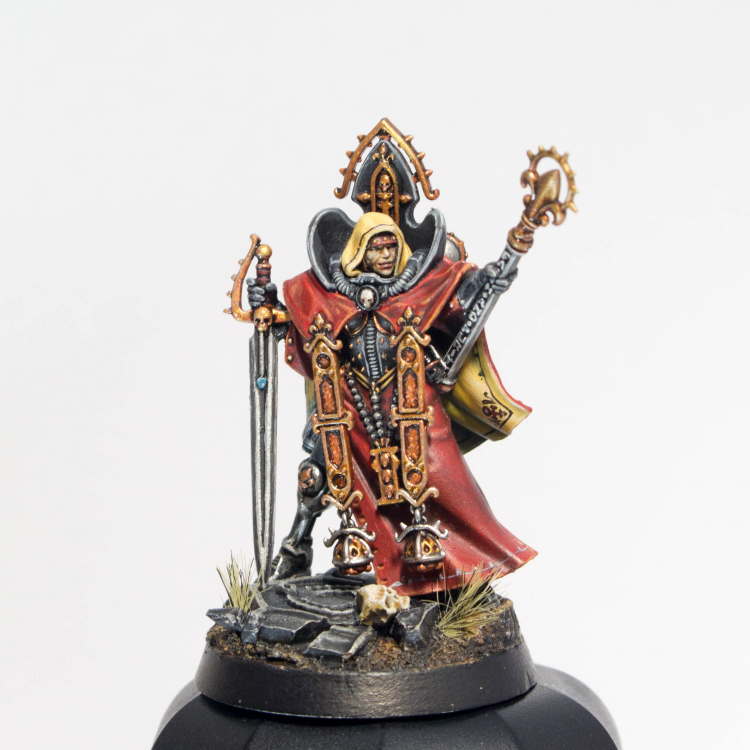
Outside of the Named datasheets, you’ve got your three generic HQ choices, the Canoness, Palatine and Missionary.
The Canoness and Palatine remain much the same, and with the advent of Morvenn Vahl your reasons for taking them are likely going to be either:
- You want to take a Blessing of the Faithful – and yeah there are some real good ones.
- You want to build a smash Canoness to fire at people.
- You’ve found some combination where you’re really, really sure that you can’t justify Vahl’s price tag.
If any of those things apply to you, then go for it – these are still attractively priced, effective HQs. The Canoness’s datasheet has also been tidied up considerably from the mind-bending horror it evolved into in 8th, being way, way easier to understand!
The Missionary gets more of a change, because as a Priest his old Aura is gone and replaced with Hymns of Battle, of which he knows one alongside the default War Hymn. While loss of the +1A aura stings, he’s still dirt cheap at 40pts (or 45 with the power maul he can now take) and feels like a very plausible include alongside Vahl if you want to build a Battalion. That’s especially true because, while you probably take a Dialogus or a Dogmata as your primary priest, having a spare War Hymn caster is going to be extremely valuable in a melee-focused list as it lets you use Fiery Conviction to buff up a unit after it jumps out of a transport. Not mandatory, but definitely a model with uses.
Troops
Battle Sisters

Sisters retain their single choice in this section, and that’s still pretty much fine as Battle Sisters remain generically fine. There are a couple of changes to the datasheet, notably that their weapon upgrade choices have been revamped to something similar to Skitarii. At nine or fewer models, you can now have one special or heavy weapon (plus a sergeant upgrade). Once you hit ten models it’s either one special and one heavy or two specials, and if you take 20 models that doubles up.
Yes, you read that right, 20 models. Importing another neat trick from Skitarii, this unit now goes to 20, and that seems like it’s plausibly quite a big deal. There are a lot of ways to amp up a unit in this book, and a full Sister block is one of the best targets for many of them, plus an exceptional way to use the Defenders of the Faith stratagem. Being able to carry round four artificer storm bolters is a surprisingly big deal too – if you’re Rapid Firing them, you only need a RR1 aura to hit the 6MW cap for Blessed Bolts on average dice.
Essentially, small units of these are still great line infantry, and there’s a real angle on going big in the new book. Good stuff.
Elites
The Elites slot has shifted up a whole bunch, with lots of new units and plenty of changes to existing ones.
Priests
You have a mighty three Priest options in the Elites slot – two re-badged existing models (the Preacher and Dialogus) and the new Dogmata. The Preacher is your most dirt cheap War Hymn caster, literally only knowing that, but they’re really cheap, coming in at 25pts base or 30pts with the surprisingly potent comedy option of buying a penitent eviscerator. This appears to be an attempt to support the incredibly awesome Pious Vorne Blackstone Fortress model. If, for some reason, you feel a chain-flamer wielding zealot fits your Sororitas theme better than the extremely antiquated metal models you can definitely pick this up, and loaded this way she’s surprisingly deadly for 30pts.
For more buff-focused choices, you have the Dialogus and the Dogmata. Re-badging the Dialogus as a Priest was an extremely smart move – she keeps her ability to alter a miracle dice used by a nearby unit up or down by one (and with no CORE limitation, is now actually better for protecting a Rhino than the Triumph is), but stapling Hymns of Battle (of which she knows War Hymn and one more) on top of that suddenly gives her real purpose. The Dogmata brings a heftier melee statline and a different set of buffs to the table, allowing nearby CORE units to shoot while performing an Action, and letting her grant one CORE unit a turn ObSec (or double counting if they already had it). That’s some spicy stuff, and she works extremely well with large Sister squads or Sacresants.
She’s probably the standout but is also the most expensive, and one of the low-key best design achievements in this book is that you can genuinely imagine taking any of these three units in the right list – no mean feat for direct competitors in the same slot.
Balms and Banners

If you like fancy battle standards the Elites slot now has two choices for you – the generic Imagifier and new Named Character duo of Aestred Thurga and Agathae Dolan. The Imagifier has, sadly, been done a little dirty, with Tale of the Stoic taking a huge hit. Instead of its old effect of ignoring AP-1 (or stacking to AP-2 for Valorous Heart) it protects nearby CORE units with -1 to wound against incoming attacks – but only at S3 or less. There aren’t anywhere near enough armies throwing that around in anger for this to feel worthwhile. It’s not all bad news, as Tale of the Faithful gets a complete overhaul to be much more broad, granting re-rolls on Advance and Charge rolls (also locked to CORE), distinctly more useful than it once was. Tale of the Warrior remains a +1S aura (again CORE) and that means that the total package you can pick up here isn’t terrible (especially as you still pick after Deployment) but is now in competition with all those Priests. There’s probably a Bloody Rose list that wants one with Faithful and Warrior both on via the Simulacrum Sanctorum relic, but other Orders are going to raise a lot more of an eyebrow.
Aestred and Agathae, the book’s second buddy cop duo, provide your other flag option, bringing a very impressive banner with a very impressive sounding ability attached to the table. Surprisingly the banner doesn’t have any static effects, but once per game you can plant the standard in your command phase, allowing nearby CORE units to benefit from all six Sacred Rites for a turn. This is incredibly flashy sounding, but in terms of what it actually does it’s kind of just fine? The unit does have a few other tricks, handing a Master Artisans style re-roll out to a nearby CHARACTER each turn, and giving you a free use of the extra relic stratagem, but there’s going to be a lot of stuff competing for your points out of this book, and it seems likely they don’t quite get there. It’s worth saying that they do have additional cool functions in Crusade, with Dolan acting as a hype act for your Saint Potentia, so if you’re trying to tell an awesome story in that mode, you’ll want to get these two in on the act.
Rounding out your buff choices, the Hospitaller looks good – they’ve lost the inbuilt ability to resurrect models (moved to a stratagem) but gained an Apothecary-style 6+ feel no pain aura for INFANTRY. There are a massive number of buff characters competing for your points, but the Hospitaller is definitely on the list if you’re going wide, and can be a good place to put the Book of St. Lucius.
Celestians
Celestians now come in two flavours – an Elite version of Battle Sisters with better stats and a few tricks, and the new melee-focused Sacresants.
Let’s get the old-school option out of the way first. Basic Celestians are a little toned down from before, thanks to Exceptional Proficiency losing a wound-buffing component and their hit boost from a nearby Canoness now only being +1 instead of re-rolls. Being able to pack more special weapons on small squads compared to regular Sisters gives them a little bit of a niche, but they’re also in competition with the improved Dominions for your points, and that sadly means they move back in the queue, despite their impressive hats.
Sacresants, on the other hand, are pretty exciting. They’re quite an unusual unit, as “durable melee” and “1W” aren’t flavours that tend to combine that well these days, but an aggressive price tag and being a great place to put all the book’s buffs means that we’re betting on these getting there.
Sacresants weigh in at 14pts per model and sport a 2+/4++ save profile, potentially augmented by the Inviolate Shieldwall stratagem for -1 to wound against them in the fight phase. Offensively, they’re swinging with either a hallowed mace (S5 AP-1 D2) or an anointed halberd (S6 AP-3 D1), and the sergeant can (and nearly always should) upgrade to a spear of the faithful, which gets the best of both worlds (the halberd profile, but D2).
At baseline these aren’t that impressive, but they’re cheap enough at 70pts for a min squad to be useful as a moderately sturdy backfield objective holder or throwaway piece. Where things start to get interesting is with buffs – Bloody Rose makes the mace build look very strong pretty much by itself, while if you start applying War Hymn or Morvenn Vahl’s buff the halberd build starts to end up in that Lychguard zone where the volume of high quality attacks you’re throwing out means only being D1 stops mattering. They can also Heroic like a character, and whenever they get charged or heroic they can always Set to Defend for +1 to hit in the ensuing fight. This unit grew on us the more we talked it over, and it feels like there’s really something to work with here.
Crazed Killers
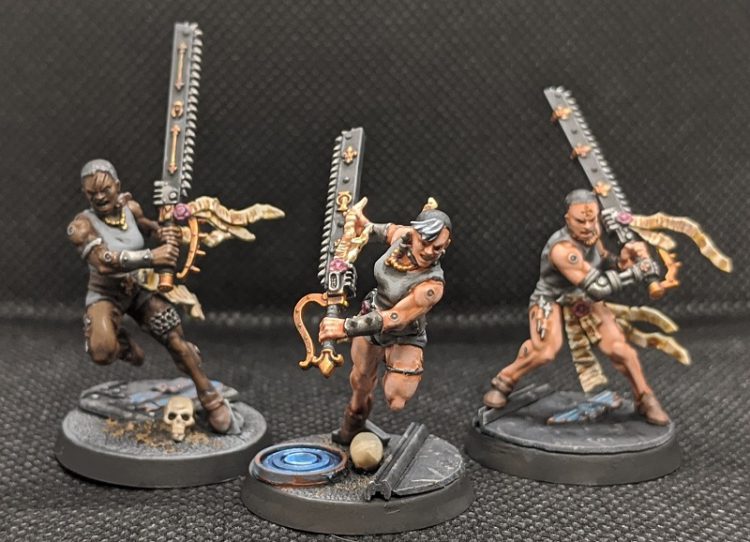
So how are Repentia doing? Stat-wise the news is good – they’re pretty much unchanged, and go down by a couple of points each to boot. The main losses for them come in surrounding changes – not being able to easily boost them to a 4++ means they’re fully locked in to being glass cannons, and losing access to an Advance and Charge stratagem means their reach out of a Rhino is considerably smaller. They do pick up a major boost in exchange, however, with the Desperate for Redemption stratagem becoming a vastly improved spin on Final Redemption from the old book. Rather than a chance of a mortal wound when your opponent kills a model, you instead get to straight up fight on death if you haven’t swung yet, making removing this unit with a charge a terminal prospect for all but the most durable of enemies. That’s obviously instead of a (pricy) fight twice, but lasting till the end of a phase wasn’t really this unit’s speciality.
That gives these a role still, albeit probably a reduced one, especially now Sacresants are competing at the same price. One squad to come in from strategic reserves, auto-charge and butcher something then demand a ranged answer is pretty plausible. Three units in many lists, maybe a bit less so. If you play with very heavy terrain that might change as you can still get access to Advance/Charge from the new and improved effects of a Repentia Superior (who also gives a mighty +1 to wound), but they have to apply it in the Command Phase so can’t when emerging from a Transport. Given how good these were before and that they’ve dropped in price it seems unlikely that they should be written off entirely, but they’re appreciably harder to deploy, so be a bit cautious.
Arco-flagellants have seen a bit of tech use recently as a trade unit into Drukhari, as they’re well-statted to rip Incubi and Wyches apart and incredibly cheap. They look pretty nifty here – they’ve gone down in points (with the only trade being that the old sergeant equivalent is now a 5pt paid upgrade) and up to baseline T4, plus had their attacks normalised to 2 attacks per swing rather than d3. If you wanted these before, you probably still do, with the only mild caveat being that they’ve picked up “2 Angry 2 Action”, in line with various other frenzied killers. Given they really are priced to move as a counter punch for hordes and glass cannons, that doesn’t seem like too much of an issue. Oh, they are also CORE, hilariously, so plenty of buffs are on the table!
Anyway, if you want Action support, of course, you were probably taking Death Cult Assassins, and now have the choice of these or Crusaders in the slot, as the latter have gone down to 11pts each. Which you take depends on what you think you need from your chaff – Crusaders are a bit tougher at a 3+/4++, but Assassins now always fight first and have gone to WS2+, giving them at least some chance of punking an enemy trash unit. Either is a fine pick, and the new way that the Ecclesiarchy Battle Conclave rule works means that you’ll sometimes end up taking one of each.
Paragon War Suits
Finally, we get to one of the marquee new kits for this release, Paragon War Suits.
First up – yes the damage reduction wording on WarCom is the same in the book, no we still don’t think it’s intended, and for the purposes of this review are assuming “to a minimum of 1” is going to be added to the effect post-haste. There’s also an apparent typo in their points as things stand, which claims they’re 240pts per model on a fixed unit of 3. We’re going to work on the assumption that these are 80pts each, but not totally invulnerable to small arms fire, until we hear otherwise.
How do they stack up, given that? Interestingly. On the plus side, these are excellent into routine and mid-ranged stuff. They’re durable (T5, 4W, 2+, -1D) and dangerous, sporting any of the three classic heavy weapons from the Holy Trinity as a main gun (10pt upgrade for a multi-melta) and either storm bolters or a d3 shot krak grenade launcher as backup. In melee their massive weapons hit with appropriate viciousness, giving them either accurate S6 AP-3 D2 attacks or taking -1 to hit for a mighty S9 AP-2 D3. The latter can be mitigated by the Exceptional Proficiency stratagem, as these have the CELESTIAN keyword, and they’re also CORE, opening up a lot of buffs (outside ones that require INFANTRY, since they’re apparently robotic enough to be VEHICLES).
A unit that’s very strong both at range and in melee is one of the few things Sororitas don’t really have, so these do generate some real interest alongside (appropriately) Morvenn Vahl. Giving a unit of these her full re-rolls in a target rich environment makes them holy terrors, ready to take a bumper sized chunk out of the best parts of your opponent’s army. Our hesitation with them is that this sort of cuts both ways – stuff that’s good at killing these (mostly recently popular D3+d3 damage weapons and enemy multi-meltas) kills them hyper efficiently, as they have no invulnerable save beyond Shield of Faith. We are aware “but it dies to shooting” is the oldest hyperbolic complaint in the book, but these die horrendously to the wrong kind of shooting, and it’s a kind that happens to be very popular right now.
We’ll see what happens with these. They might be a spectacular enough entourage for Vahl that taking a spin on a unit is worth it. Bringing a Dogmata to push their invulnerable save to 5++ with Litany of Enduring Faith and hand them ObSec might close all their gaps. Going full Nundam Wing with 3×3 might overwhelm the enemy’s anti-tank weaponry. There are worlds in which these end up good, but we’re not 100% solid on buying out your FLGSes pre-orders either. To be fair, that’s the sort of power level a new unit should be landing at!
Fast Attack
Seraphim
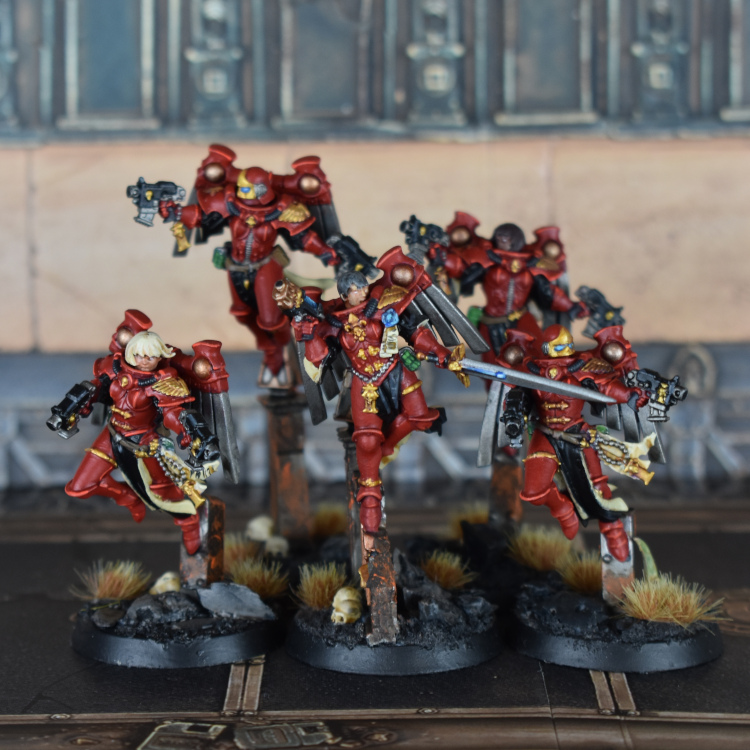
Seraphim get a very cool buff – their hand flamers are now Ministorum hand flamers, the same as regular ones but with S4 instead of S3. This is almost certainly a way to justify the 5pt cost per gun (see also artificer-crafted storm bolters elsewhere), but at least if GW are going to insist on a minimum 5pt cost for a weapon they’ve gone the right way about it by making the gun actually worth 5pts. It’s not all bad on the cost front, either, as the base Seraphim cost 14pts instead of 15 now, and get boosted to 2A and WS3+ base, giving them a little more of a chance at finishing something off in combat (and making the sergeant power sword more attractive)
The downside for them of course is as was specified in the Stratagems section – Deadly Descent’s timing has changed and it also no longer buffs the range of weapons, so inferno pistols are more or less completely dead as an option. This is a real shame for the unit, and a bizarre thing to change given that the entire purpose of the stratagem in the first place was to address this historic issue with the weapon.
That leaves 90pts for a unit with two hand flamer models as your probable loadout for these, and especially at S4 (or in Ebon Chalice where you can proc mortals) there are homes for that.
Zephyrim
Making a move from the Elites slot to Fast Attack, Zephyrim are now directly competing with Seraphim and Dominions, while also having lost their former ability to re-roll wounds. They are at least a point cheaper and gain an extra Attack to compensate – a trade-off we’ll compare in Hammer of Math at some point. They’ve got some routes to pick some punch back up, obviously doing very well out of Morvenn Vahl’s re-rolls and getting a +1 to wound strat in the form of the new version of Embodied Prophecy, but the reduction in how universally dangerous they are stings a bit. This is a unit where we got a bit higher on them again after discussion, having initially been very put off by the loss of re-rolls, and similar to some other units on the roster there’s probably still use cases for one supported squad, but lists that previously went all-in on them might need to look wider.
Dominions
Oft-ignored in the 8th edition book, Dominions have had a little review in 9th and they look set to show up regularly again. For no increase in points, their Holy Vanguard ability now works as it did in the past, allowing them to move not just themselves but also any transport they’re embarked in – and to taxi another unit as well, if embarked in the same vehicle. This is a great change, since you can now push them forwards with much lower risk to the unit, and also utilise the movement to support other units getting into the mix as well. They also can still take up to four Special Weapons in a squad of 5, as well as throwing a combi-weapon on the Dominion Superior – four meltas and a combi-flamer makes for a very easy route to unlocking the Holy Trinity stratagem, for just 110pts. Four artificer storm bolters also gives you an extremely cheap route to switching on Blessed Bolts, and even the option of going with five flamers (combi- on the sergeant) at 90pts presents a nasty damage spike with Cleansed by Fire your opponent has to watch out for. This unit is incredibly improved, overall, and looks to be a staple.
Heavy Support
Engines of Redemption
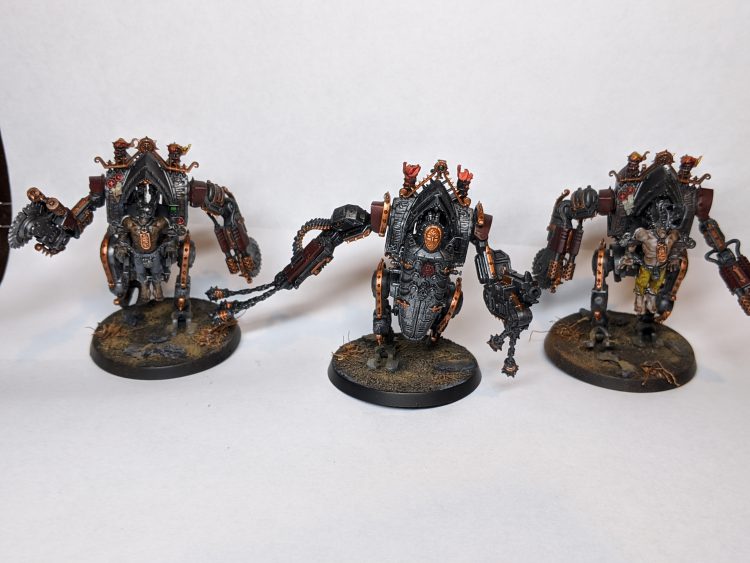
Mortifiers and Penitent Engines have been hit with a reasonable amount of shuffling and normalisation, with GW making the (correct) assessment that incredibly similar models with subtly different statlines down to the movement characteristic wasn’t actually that interesting. These now both get the 5++, both have Zealot and have had their move averaged out at 8”. They can also both use the Final Redemption stratagem to switch on the old version of the Mortifier’s mortals on death ability. Weapon-wise, the flails get nerfed down to 2 swings per attack and S5, while the buzz blades and heavy flamer both get boosted, with the former increasing to AP-4 and the latter getting the Ministorum treatment for S6. This evens out the choices a lot here – in the old book the flails were essentially objectively correct at all times, and access to heavy bolters made the Mortifiers a shoe-in; now things are a bit more flexible (especially as Cleansed by Fire can work on a full unit of either and 48 S6 AP-1 autohits sure is a thing).
In terms of what differentiates them, Penitents get another thing going for them – they now have inbuilt Advance/Charge, plus boosted pile-ins and consolidation so they can run amok once they arrive. On the Mortifier side, they can still take heavy bolters, giving them more ranged utility (though lose the ability to treat them as Assault weapons), can still upgrade a model to an Anchorite for an ablative 3+ save, and if they’re charged and killed before they swing, can fight before dying on a 4+.
Realistically, the stock Mortifier build of bolters/flails goes down in value a bit, but many other permutations of both of these units go up in value, especially buzz blade/flamer Penitents. Don’t forget that these can also benefit from the War Hymn buff now as well, making them even deadlier. There should definitely be ways to make these work.
Retributors
Anyone who’s been playing Sisters is probably dreading reading this bit and yeah – it ain’t great. The good news is that you aren’t stuck on box weapons, as some feared – you can still pick freely. The bad news is everything else. Retributors have been substantially cut down to size, losing their dedicated stratagem, losing move/shoot without penalty (ignoring cover instead) and getting a new wording on the Cherubs that looks like it’s intended to only allow you to use one a turn (edit: this has turned out to be an incredibly contentious point, and currently most people come down on still being able to use two. Take a look at Ruleshammer for a deeper dive into the arguments). There’s a reversion to 12pts each along with this, but that’s small change compared to what’s lost here. Despite everything, there probably is still a place for the odd multi-melta unit of these, just because it gets far more of those shots on the table far more cheaply than anywhere else, but in a book where there’s been a considerable number of tall poppies cut down to size, this is maybe the hardest single blow. Something needed to change here, as Retributors in their previous incarnation could be metagame warping, but as sometimes happens there have been a bunch of changes made at once that probably swings things a bit far. If you’re looking at your collection of 15 of these and despairing, it may be worth looking at Argent Shroud which can still allow them to move and shoot without penalty – but possibly don’t expect to keep using all of them even then.
Tanks
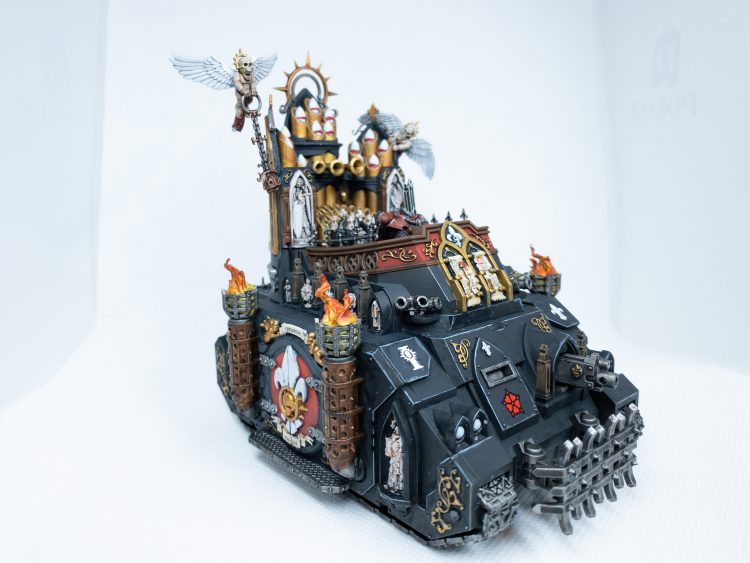
Closing out Heavy Support we have two flavours of Tonk, the classic Exorcist and the new fangled Castigator.
Sadly, in line with a lot of main battle tanks this edition, there’s really not that much here. The Exorcist drops in points slightly but catches several nerfs (most notably dropping to T7) in doing so on top of the inbuilt pain of not being CORE. The Castigator, meanwhile, has a pretty eye-catching statline on its main gun but just isn’t worth the point cost, especially as it’s again T7. These datasheets (and the Immolator later on) are just a bit baffling, honestly. The Exorcist was seeing infrequent use as a one-off pick before, and if you’d left the stats the same and given it the point drop here to account for CORE it would have been fine in that same role. Why did it also need a bunch of downgrades? Tanks are cool. The Castigator kit slaps. Why are they not even close to good?
Dedicated Transport
Sororitas Rhinos
The ‘umble Rhino is back, doing much as you would expect it to do – costing 80pts, firing a storm bolter, benefiting from Shield of Faith. Probably the biggest new change is that it’s HALLOWED, allowing it to benefit from the Thrice-blessed Hull stratagem, which is kind of funny. There’s still plenty of stuff that wants to ride in these, arguably more than ever with the advent of Sacresants and the boost to Dominions, so expect to still be packing 2-3 a lot of the time.
Immolators
Wings Note: I reached the following unfiltered Corrode-ism late at night during the review compilation process, and honestly decided it didn’t need changing.
WHY is this 120pts? WHY? Who can explain this to me? It’s a Razorback with a weak invulnerable save, why is that worth 120pts? That’s for the default heavy bolter build, by the way – the iconic flamers or the twin multi-meltas bump the cost to 130pts or 150pts respectively. Why do you hate Rhino-chassis tanks, Games Workshop? What did they do to you?
Fortification
The Battle Sanctum still exists, and has, hilariously, had Obscuring added to its keyword list, meaning you can bring your very own fortress of solitude to the table to hide a backfield objective – if, of course, you can set this up. There is still nothing here that lets you get around the standard Fortification setup rules, making it extremely hard to place on some boards, and gaining a Miracle dice from it also now requires an Action (albeit an easy one that finishes at the end of your turn, which can be done by a 25pt Priest – another place where those cheap guys shine). Realistically, the limitations on this mean that you’re only using it if you are extremely confident in the lay of the land at a tournament you’re going to and have some galactic brained plan for how to use it. If so, go off; otherwise the kit absolutely rips, so use it to make your table look cool.
Our Thoughts
How They’ll Play
Sisters of Battle are going to reward keeping your opponent under pressure, with the main body of your army attacking in force to push the heretics back, and harrying flankers constantly threatening to pick off anyone who tries to escape. The Codex provides great short ranged firepower and great melee damage dealers, plus a whole bunch of ways to amplify your key tools at crucial moments, most notably Morvenn Vahl herself. Vahl makes a great central anchor for the main body of your army to advance around, ensuring everything is operating at peak efficiency and threatening to take matters into her own hands if the opponent gets too close. Between her and various buffs from Priests, whichever unit you have nominated as the tip of the spear each turn is going to be supremely deadly, and your goal is to have your opponent’s lines break before you as you march to dominance on the table.
If they try and work around your main force, the other thing this army does particularly well is field fairly independent flanking or troubleshooting units. Repentia coming in from Strategic Reserves and deploying an Act of Faith powered charge threaten to mince whatever they touch. Hand flamer Seraphim or pretty much any Dominion loadout provide mobile damage dealers. Newly improved Penitent Engines are very cheap wrecking balls that need minimal backup and demand to be dealt with. Finally, both Celestine and surprising new contender Ephrael Stern are great roving hunters. Whether the foe faces you head on, or try to flee like cowards, you should be able to bring the Emperor’s justice to them.
The only caveat to throw out in this section is that there does seem to have been a concerted effort to shake up the tactics used by existing lists, and experienced Sororitas players will need to change up their playstyles a bit. Notably, it’s much harder to build an unshiftable anvil of infantry (as you cannot boost Shield of Faith to 4++ widely, and get a toned down Valorous Heart/Imagifier interaction), and the hyper-efficient trade units have either been toned down or are harder to use. You can’t rely as much on surgically neutralising your opponent’s best stuff and having them break on your anvil – you need a more proactive plan to take the fight to them. Happily, plenty of the new and improved units support that!
Hot Takes
Liam
My initial read on this book was not favourable – it felt a lot like the designers had looked at successful lists in late 8th and early 9th and specifically kicked the legs out from under everything in them, to a degree which was a little unpleasant. Looking at it with fresh eyes I still think a couple of those choices are silly – I won’t get over the Deadly Descent thing, nor dropping Storm of Retribution entirely – but overall it feels like a book that’s better balanced within itself, and taking away some of the datasheet abilities allows there to be a more interesting diversity of Order Convictions, Stratagems, etc. Morvenn Vahl immediately feels suffocatingly good, though – 265pts is not enough for all that she can do.
Exactly how powerful it is is hard to gauge; it certainly doesn’t seem bad, and we’ve been working through some possible lists and there’s interesting stuff to be had and meaningful choices to be made in terms of the playstyle you’re going for, which influence the very basic fundamentals of list design. That’s an improvement over the previous iteration which coalesced pretty quickly around Valorous Heart and Bloody Rose as the always-preferable best options, and fairly narrow choices to be made for each. More time to think things through and try out new options or rethink old ones may reveal more, but just from thumbing through over the last couple of days this book feels like a comfortable tier 2 or lower tier 1 – competitive with Death Guard and Dark Angels, but possibly not reaching the heights of Drukhari. Having both this and Adeptus Mechanicus fresh in the meta at the same time as a couple of X factors will be interesting, to say the least, especially with some gentle nerfs to Drukhari potentially shaking things up too.
James “One_Wing” Grover
I’m in a similar boat to Liam here – every time I read this book I liked it more, and have ended up pretty favourable on it overall with a couple of exceptions.
For someone with an intimate working knowledge of the existing book, first impressions can be rough. It’s pretty clear we’re now reaching a point where these books were written with at least the initial stages of the 9th metagame as an available datapoint, and thus we’re seeing what happens when an army that was unquestionably top tier gets a re-vamp – and in places it isn’t pretty. Not all of that is unwarranted, because some of what made the existing book strong (notably, Retributors) just wasn’t particularly fun or healthy, but there are a few places where multiple nerfs have been dropped on a single unit in a way that probably swings the pendulum too far the other way – even Retributors probably could have borne to lose either move/shoot or their stratagem, especially with Acts of Faith now not being available in soup.
The reason the book grows on you is that things are very far from all negative. Where units have been nerfed there are often small point cuts that, while they don’t take them back to top tier all-stars, at least ensure they’re still functional. The internal balance of Orders has been massively improved, significantly increasing the diversity of lists we’re going to see. Quite a few units get some significant new utility, notably Dominions and Dialogi, with the Priest mechanic in general fitting into the codex well and looking like fun to play with. Ephrael Stern looks like an absolute blast to put on the table. Wide-ranging upgrades to special weapons let you scatter some real teeth around. Blessings of the Faithful feel like one of the best pitched upgrade mechanics we’ve had yet (outside the mild Vahl issue we’ll get to).
Honestly – if you’re coming to this and you’re not highly familiar with the existing book, then this is going to look very appealing right out of the gate, and I’m excited to see what people can do with it on the table. My two big gripes with the book in its own right are Morvenn Vahl and the tanks, for opposite reasons. Vahl seems ludicrously over-pushed, which feels unhealthy for a Supreme Commander. I think she’s going to be in every tournament list and people are going to get quickly bored of seeing her, and like all models who are good at everything, the only real slider to impact that is her cost, which would badly annoy players who pick her up in good faith. I really, really wish she didn’t have the shoulder missile launchers, as those are what push her over the top to a point where she’s just never bad. At the extreme other end of the scale, Exorcists and the new Castigator are some of the coolest tank kits GW make, and the fact that they are incredibly anemic on the tabletop is baffling to me. The Exorcist in particular was in a really good place in the last book, where you occasionally saw one or even two in lists built for it but weren’t dominant. It doesn’t even look like an attempt has been made to keep it in that slot, and the Castigator is not much better. I hope we see some improvements to these at some point.
Ultimately, those are gripes covering only a small number of units, and I’ve ended up pretty warm on this book. It’s a change, but it looks like fun to use and sands the most meta-warping edges off the old roster. Definitely excited to see this one on the table.
Army Lists
Wings
While they’ve been taken down a notch I’ve always been a big fan of the Bloody Rose, and I think there’s still plenty you can do with them in here. This is what I’ve put together to show off a mixture of the new models and some upgraded favourites:
HQ
Morvenn Vahl, Warlord, Righteous Rage – 265
Missionary, Refrain of Blazing Piety – 40
Canoness, Blessed Blade, Saint in the Making – Indomitable Belief, Litanies of the Faith, Blessing of the Faithful – Emperor’s Grace – 80
Troops
Battle Sisters x20, 4 artificer storm bolters, chainsword – 240
Battle Sisters x5, chainsword – 55
Battle Sisters x5, chainsword – 55
Elites
10 Sacesants, halberds, spear – 145
5 Sacresants, maces, spear – 75
5 Sacresants, maces, spear – 75
9 Repentia – 126
Dogmata, Open the Reliqueries – The Sigil Ecclesiasticus, Litany of Enduring Faith, Catechism of Repugnance – 65
Paragon Warsuits, mace (sergeant), swords, multi-meltas, storm bolters – 270
Elites (No slot)
2 Crusaders – 22
2 Death Cult Assassins – 26
Fast Attack
5 Dominions, 4 melta, combi-flamer, chainsword – 110
5 Dominions, 4 melta, combi-flamer, chainsword – 110
Dedicated Transport
Rhino – 80
Rhino – 80
Rhino – 80
Total – 1999pts, 10CP
This army is designed to play the gameplan outlined in the “how they’ll play” section, with an extremely solid core designed to roll forward and overwhelm the enemy, with the threat of a reserved Repentia unit hanging over the heads of anyone who wants to try getting clever. You start the big Sacresant unit in one Rhino and one each of the smaller units and Dominions in the other two, letting you push the Rhinos up a little out the gate and threaten a counter-charge into any enemy that tries to claim the mid-board right away.
Your second wave brings three alpha units – the big Sisters block, the larger Sacresant unit and the Warsuits. The Sisters want to push onto a key objective, buff up with Defenders of the Faith and Catechism of Repugnance and start blasting away and making a nuisance of themselves, with an option on Blessed Bolts to spike a key target. The Warsuits have the Dogmata to boost their invuln to 5++ with Litany of Enduring Faith and mostly want to be taking Vahl’s buff and going wild with it. I’ve left the storm bolters on them so they’re a backup target for Catechism and have lots of shots for re-rolls. Finally, the halberd Sacresants are there to ensure you have something that can punch through damage reduction – stick War Hymn on them and that’s an avalance of accurate attacks that will get stuff done into most targets.
The last standout is the exceptional once a game defensive bubble that the Canoness can throw up with Emperor’s Grace. In an ideal world you save this for the moment the opponent is on the ropes, but if you take the first turn and their shooting looks nasty then blowing it right out the gate to keep the warsuits and large Sister block safe seems plausible.
The big test for the list would likely be whether the warsuits held up, but fully supported as they are here I’m definitely interested in giving them a go!
Wrap Up
Another Codex added to the armouries, and another one that looks sure to have some play on the tournament tables. Check back in next week for our Crusade review, and if you have any comments, questions or suggestions hit us up at contact@goonhammer.com.
